M.B. Dallocchio's Blog, page 6
August 21, 2013
Female Combat Veterans: The New Vietnam Veterans?
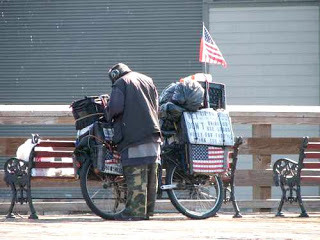 Picture this: A combat veteran is getting publicly shamed. Their service is spat upon; various media outlets perpetuate misinformation about them; veterans charities and nonprofits exploit them; and the general public doesn't seem to accept them either. They are criticized, scrutinized, and are often spoken about with disdain, question, and shame. The combat veteran faces constant antagonization and, as a result, experiences a failure to reintegrate after war and is vulnerable to homelessness, substance abuse, prison, and/or suicide.
Picture this: A combat veteran is getting publicly shamed. Their service is spat upon; various media outlets perpetuate misinformation about them; veterans charities and nonprofits exploit them; and the general public doesn't seem to accept them either. They are criticized, scrutinized, and are often spoken about with disdain, question, and shame. The combat veteran faces constant antagonization and, as a result, experiences a failure to reintegrate after war and is vulnerable to homelessness, substance abuse, prison, and/or suicide.No, this isn't 1968. This is 2013. And that combat veteran is a woman.
One doesn't have to look very hard to see not just the war on women, but the war on women veterans. Men are writing books protesting integrating women not just into combat arms, but the military all together. Women are willfully defending misogyny and are utilized as puppets for publicly disgracing women's abilities, accomplishments, and honorable service. As a female combat veteran, I have spoken up quite a bit about this and have been pushed aside and silenced. I've been there, done that. Yet I get a clear view of a non-stop circus shredding my service apart quite vividly. After all, in an age where military rape is more palatable than hearing a story about a woman performing effectively in direct combat, who wants to hear the truth? And as a female combat veteran, one struggles in finding any real reasons to continue living in such an environment with no apparent and attainable way out. Is it any surprise than women veterans are committing suicide at alarming rates?
Los Veteranos de Arizona
The underdogs of before certainly have more compassion. The veterans art group "Los Veteranos de Arizona" who are predominantly male Vietnam combat veterans - and Native American and Hispanic - were incredibly supportive to the point where they convinced me in 2010 to show my work, which I had held onto for years, in a public setting. No pissing contest of who did what and when that you often see with the OIF/OEF crowd. While Iraq and Afghanistan veterans groups snubbed me to maintain their boys' club status quo, Vietnam veterans groups, especially those of color, took me in. They just allowed me to be me and did not judge me. And really, that's all I ever wanted.
After all, Vietnam veterans, especially those of color, knew not only of being shunned upon return to the United States and being judged, but also the discrimination faced due to their race. In addition to a group of women scattered across the country who never stop caring for women veterans (veterans and non-veterans alike), Vietnam veterans of color have been one of the most supportive groups of me being a female combat veteran. They not only served in severely traumatic environments, they were treated as outcasts - and dealt with everything in the first paragraph. While people nowadays are far more supportive of "the troops" in general, it still tends to be male-centric. Just take a look at your local community resources and what's really there for women. Give those resources a call and put them to the test if they offer anything for women. You're in for a real treat. Despite studies that show that women perform effectively in combat and that there is no real difference in handling PTSD when it comes to gender, we're still slammed quite openly even in this flag-waving, yellow ribbon-wearing environment. Vietnam veterans I've worked with seem to get that and see history repeating itself under a different banner.
"I'm talking. I'm up here." Confronting Patronizing Patriarchs
In this video, Comgresswoman Tammy Duckworth (D-IL) addresses a disrespectful individual who does not respect her sacrifices. Braulio Castillo, an IRS contractor, goes on to defend his dubious claim of injury from playing football in prep school as a "sacrifice" in defense of the United States - although, he's never picked up arms in defense of it. The video displays the ever-eloquent ass-chewing Congresswoman Duckworth delivered to blowhard Castillo. It was magic time in the bureaucratic forest. Unicorns and dreams filled with cotton candy could be seen for miles around after this glorious scene.
Confronting this poor behavior and arrogant attitude by males (veterans and non-veterans alike) is a must. While I have seen and experienced positive feedback and support by other males in addressing the issue of institutional and indirect violence towards women, I have far more experience in the opposite end of the field with unashamed blowhards like Castillo. If you're a woman, a female combat veteran, you can bet there will be a pissing contest, a comparison of experiences with such men, and if they come up short, they'll dream up situations and people that sound like they've allegedly done more than you have. It's appalling, but it's generally accepted. Boys will be boys? Unacceptable palaver. However, Rep. Duckworth halts Castillo's self-serving frothing at the mouth with a two-by-four of plain, objective truth. He's no hero. And he had the stones to stand in front of a double amputee, female combat veteran and attempt to interrupt and disrespect her in public. This is what happens when "keeping it real misogynist" goes wrong.
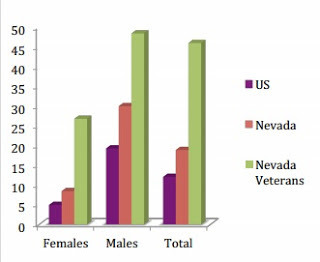 Suicide rates for Nevada, 2008-2010
Suicide rates for Nevada, 2008-2010Reintegration
Homelessness and suicide rates are climbing everyday not just for veterans in general, but more specifically women veterans of recent conflicts. Examining this study from Nevada, there's a lot more work to do in properly reintegrating women veterans into civilian life, to include validating their service and allowing for opportunities for growth, self-worth, and self-actualization - you know, reasons to not commit suicide. It's not just about resources and emergency services, it's about addressing the problem with long-term solutions. Not just waving the flag and bumper stickers, but offering chances to improve, develop, and contribute to society with pride and dignity without dealing with the current judgment and public humiliation. However, in order to establish adequate resources for women, we must address everything in the first. damn. paragraph.
After dealing with another patronizing patriarch last night, and fortunately getting it taken care of appropriately, I was fortunate in finding a book that I had been searching for years to read: Ceremony by Leslie Marmon Silko. While it discusses the homecoming of a mixed race Native male veteran from WWII, I'm finding a lot more in common here regarding the homecoming and reintegration process. While veterans of other eras provide their stories of survival past the ridicule and ostracization, novels like Ceremony also help in many ways. The stories I hear retold from veterans of all eras who struggled even harder to find inner peace - and lived - give me a sense, as a female combat veteran, that things can indeed get better. Here's hoping.
Also see: Lifting the Ban, Lifting the Veil
Published on August 21, 2013 02:40
August 18, 2013
Women Warriors and Publishing
 The numbers of books by women veterans who've deployed are slowly growing, but stacked up against their male veteran counterparts that number is instantly dwarfed even more so. Initially, when I started writing "Quixote in Ramadi," I began to do a little research on what was already published by women combat veterans or women veterans from other eras and perspectives. After all, one should conduct a bit of recon for both examining the competition and seeing if one's story is unique enough to stand out. But I found that there was a great disparity: there were very few books, if any, eight years ago that were stories covering women of color.
The numbers of books by women veterans who've deployed are slowly growing, but stacked up against their male veteran counterparts that number is instantly dwarfed even more so. Initially, when I started writing "Quixote in Ramadi," I began to do a little research on what was already published by women combat veterans or women veterans from other eras and perspectives. After all, one should conduct a bit of recon for both examining the competition and seeing if one's story is unique enough to stand out. But I found that there was a great disparity: there were very few books, if any, eight years ago that were stories covering women of color.Years later, Kirsten Holmstedt (a non-veteran author) wrote "Band of Sisters" in 2008 and "The Girls Come Marching Home" in 2009 - I was featured in the latter piece. While this was a diverse collection of stories - ethnically and context-wise - there still weren't any first-person perspectives available written by a female veterans of color. Why does this matter? One doesn't become voiceless, as Arundhati Roy said, but only deliberately silenced or preferably unheard. I don't know about you, but I do not want to be in either category. And at that rate, I had already experienced being silenced while in the military and preferably unheard as a minority female combat veteran upon re-entry into the civilian world. The only way, it appeared, to get my story heard was through a white woman speaking on my behalf. I couldn't settle on that. Below is a collection of books by white female veterans, white female non-veterans, and minority female veterans:
Books by White Female Veterans Hesitation Kills - Jane Blair (Officer)
Love My Rifle More Than You - Kayla Williams (Enlisted)Rule Number Two - Heidi Squier Kraft (Officer)*
*An overly kind, and undeserving depiction of Army Mental Health
Books by White Female Non-Veterans About Women Veterans Band of Sisters - Kirsten Holmstedt
The Girls Come Marching Home - Kirsten Holmstedt
When Janey Comes Marching Home - Laura Browder
When Johnny and Jane Come Marching Home - Paula CaplanThe Lonely Soldier - Helen Benedict
Powder - Lisa Bowden
Undaunted: The Real Story of America's Servicewomen in Today's Military - Tanya BiankWomen in Combat - Rosemarie Skaine
Women in Comat - Civic Duty or Military Liability - Lorry Fenner & Marie deYoung
**Also, there are anti-female veteran books written by men, but that'll be another post for another day. Not to mention totally counter-intuitive in the healing process.
Books by Minority Female Authors
All I Could Be: My Story as a Woman Warrior in Iraq - Miyoko Hikiji
Zero to Breakthrough - Vernice Armour
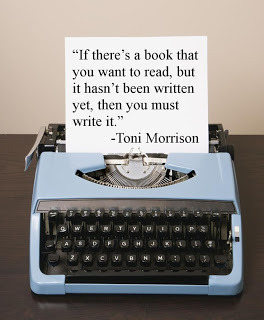 In 2011, this demographic did change significantly - and by a figure of 1. Venice Armour, who has fantastic branding and media presence, ended up on Tavis Smiley and Oprah, and now can be seen in professional workshops and speaking events about empowerment. This is the only exception I have found regarding a female combat veteran. While I found Armour inspiring, and she is one of the women profiled in Kirsten Holmstedt's "Band of Sisters," it did inspire me to keep on working toward publishing my own story - even if I had to do it alone. As Toni Morrison said, "If there's a book that you want to read, but it hasn't been written yet, then you must write it."
In 2011, this demographic did change significantly - and by a figure of 1. Venice Armour, who has fantastic branding and media presence, ended up on Tavis Smiley and Oprah, and now can be seen in professional workshops and speaking events about empowerment. This is the only exception I have found regarding a female combat veteran. While I found Armour inspiring, and she is one of the women profiled in Kirsten Holmstedt's "Band of Sisters," it did inspire me to keep on working toward publishing my own story - even if I had to do it alone. As Toni Morrison said, "If there's a book that you want to read, but it hasn't been written yet, then you must write it."It was useless to lament about the availability of a story that told of excess, corruption, colonialism, and prejudice. It was a waste of time and emotion. All this time I had spent scribbling in my journal and keeping docs on Word only meant that I had to bite the bullet and just put my story out there. I had been looking, for years, for a book that I could relate to and not feel as alone as I did. But the answer was, that story existed: It was mine. It was just a matter of letting someone read it. It didn't matter if it hit the NYT Bestseller list. It mattered to me that if it made someone, anyone, feel less alone, then I did my part. It mattered to me that someone, anyone, knew that this type of pain existed. And there are others like me out there. If you would like to delve into that story and wrap your head around it, click here to read "Quixote in Ramadi: An Indigenous Account of Imperialism" on Amazon.
Published on August 18, 2013 11:02
August 4, 2013
"We Support Our Boys!" Women Veterans Take Another Hit
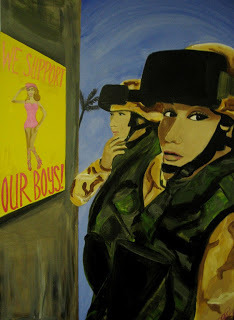 Food for veterans organization thought: When raising money for veterans, please don't use pin-up girls, Hooters, or the like to support all veterans. Some of us are into dudes or are - dare I say - straight women. You heard me right the first time, and before you go scampering off into Wikipedia to confirm what sounds like urban legend, I must inform you that, yes, Virginia, women have served in direct combat too - and about a decade before the ban on women in combat was lifted.
Food for veterans organization thought: When raising money for veterans, please don't use pin-up girls, Hooters, or the like to support all veterans. Some of us are into dudes or are - dare I say - straight women. You heard me right the first time, and before you go scampering off into Wikipedia to confirm what sounds like urban legend, I must inform you that, yes, Virginia, women have served in direct combat too - and about a decade before the ban on women in combat was lifted.Some of you may be unfamiliar - or may be acquainted through this blog or elsewhere - of the mocking, degradation, and shaming of women veterans who have honorably served this country - even outside of and well beyond their job description. So as an introduction or a refresher, I have supplied a list below to get you familiar with the constant defecation upon the service of women combat veterans in particular. While some of the points below apply to all women veterans, I've decided to go the combat veteran route as the mainstream media tends to shy away from it in favor of stories that make women appear to be mere victims or unfit for service. Even rape in the military is far more palatable to the general American public than women performing effectively in combat. Ten years after Team Lioness first started and five years since the documentary Lioness came out, many Americans are still unaware of women's contributions to this country and the spotlight is given to those all-too-willing to dump on our service. Funny how that works out.
Microaggressions and Attacks on Women Combat Veterans:

1. The "Support Our Boys" theme
Some may say sexy pin-up girl car washes may be a great way to raise morale and funds for charities, but whose morale are we considering here? While some may argue that the pin-up girls themselves could be severely attention-seeking women using this as a route to expand their influence and business at the expense of veterans, but ultimately, aren't these male-dominated organizations just perpetuating the stereotypes of a submissive woman with a vacant gaze? Stripping for charity may seem noble to some of you, but certainly not to many women veterans I know. It's the exploitation of women that is championed by such organizations that keeps women veterans alienated and, even more so, disrespected. In short, if Miss Pin-Up Bombshell has daddy issues, direct her to a therapist, not a car wash.
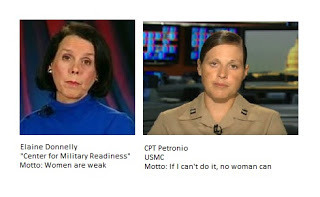
2. Championing women who are misogynists
Between Elaine Donnelly and CPT Katie Petronio (USMC), various media outlets are being generous in their air time or articles that support women who, well, hate women. Why get someone to shame women and put them down when men can find women who do the job even better? Women veterans get to watch both a Stepford Wife and a female Marine take a dump on our service and are facilitating the ongoing war on women. The first article, even points out that the same issues were argued when integrating minorities in the military. Here's another morsel of said ignorance from the Business Insider.
Marines Share Frank Views With Hagel on Women in Combat - NYT
Plans to Integrate Women Into Combat Begin - ABC News
Female Troops Against Women in Combat - Business Insider
First of all, Elaine Donnelly is not a veteran, let alone never served in combat. She believes women are weak and should know their place: in a kitchen, barefoot and pregnant. Second, as a member of Team Lioness in Iraq, FET females in Afghanistan had a much easier time with locals than we did with Iraqis, two different countries with very different issues. Third, CPT Katie Petronio is an officer. Out of all the Lionesses and FET members I've known, only one officer has served that I know of. Even if an officer is out on a mission, chances are, they're not doing the heavy lifting - this goes both ways with male and female officers. Her story about her body falling apart due to combat as dubious at best and an insult to all women at its worst. However, she makes a great puppet for the far-right as well as Elaine Donnelly.
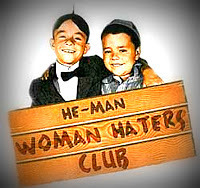
3. Military and Veteran sites that constantly shame women veterans
Uncle Sam's Misguided Children on Facebook, Military.com, you name it. Look at the comments and you'll see a very open and unashamed bashing of women veterans and honorable service. Many of such trolls claim to be veterans, and that may be partially true, but a look at some of their personal profiles may prove otherwise.

4. Lack of housing resources for women veterans
Most veterans housing are exclusively for men, and if they take women, chances are that they won't allow them to bring children. The list goes on for organizations that either don't have room at the inn or, even worse, nonprofits popping up that don't know anything about women veterans and are using us in their campaign for grant money and donations. This is both institutional discrimination and exploitation.

5. Limited VA and State resources for women veterans
Talk to a VA women's coordinator (federal) or a state women veterans coordinator (state) and you'll get the proof that you need as to where our nation really is in responding to the needs of women veterans. While MST may be a hot topic, ask them to explain what Team Lioness or FET is and you'll more than likely be met with a deer-in-the-headlights gaze. And these are supposed to be our experts. With that said, asking the general American public about women combat veterans and you'll find even greater ignorance and surprise.

6. VA coming to terms with female combat veterans
MST and PTSD seem to go hand-in-hand for some VA employees and veterans advocate groups regarding women veterans, but this isn't always the case. For example, I didn't experience MST, but I did experience combat and severe racial persecution. Trauma is trauma, regardless of the point of origin. However, when a woman is claiming PTSD, it's often followed up with an inquiry about rape. This country has yet to grasp that women have been serving in direct combat for the past decade.
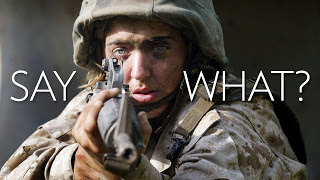
7. Media constantly repeating that "Now women can serve in combat"
This is an on-going facepalm issue of mine. Instead of reporting that it's been happening for over a decade now, the idea of women in combat is being reported by many mainstream media outlets as a "new" situation based on the lifting of the combat exclusion ban this year. It's also nice to see how a military-serving newspaper like Stars and Stripes chose that specific wording for their article. Women combat veterans are in season, I suppose.
How Cowards are Pushing Women into Combat - Fox News
Supporters, Critics Open Fire on Women in Combat - Stars and Stripes
Now, Women Can Serve in Combat - MSNBC
Women in Combat a Dangerous Experiment - CNN
How do you think women who've already served in combat in 2003 and are fighting for deserved VA benefits feel when both their fellow veterans and the media display both ignorance and insult?
On a brighter note, kudos to these outlets who did get it right:
Women in Combat: Now It's Official, But They Were Already Fighting - International Business Times
New U.S. Combat Policy Affirms Role Women Already Play - LA Times
Panetta is Lifting Ban on Women in Combat Roles - NPR
Women in Combat Already Here - US News & World Report
The 11 Most Batshit Crazy Reactions to Women in Combat - Jezebel
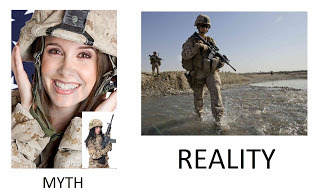
8. Media and veterans organizations posting photos of women with uniform violations
Private Benjamin was just a movie. But that doesn't stop people, veterans or the media, from posting pictures that condescend to women and, more importantly, women veterans. Nothing says, "You're not welcome home" quite like shaming women and spreading misinformation about their contributions in combat.
The winning source of this rant: "Pay It Forward Tucson"
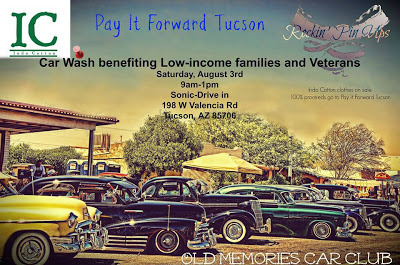
Tsk, tsk. I hate to be the bearer of bad news again, Tucson, but if you decide to "pay it forward" through objectification, don't leave men out, okay? Vets4Vets - which no longer exists - made this mistake as well and it doesn't appear that Tucson has learned anything from it.
:::::::::::The More You Know:::::::::::
Published on August 04, 2013 15:45
July 24, 2013
The Absence of Native American Power
In an extended clip from this weekend’s Moyers & Company, writer Sherman Alexie, who was born on a Native American reservation, talks to Bill about feeling “lost and insignificant inside the larger culture,” and how his culture’s “lack of power” is illustrated in stereotypical sports mascots. “At least half the country thinks the mascot issue is insignificant. But I think it’s indicative of the ways in which Indians have no cultural power. We’re still placed in the past. So we’re either in the past or we’re only viewed through casinos,” Alexie tells Bill. “I know a lot more about being white than you know about being Indian.”
Published on July 24, 2013 09:09
July 21, 2013
George Zimmerman: The Case of the Curious Coconut
“Here was an ugly little girl asking for beauty....A little black girl who wanted to rise up out of the pit of her blackness and see the world with blue eyes. His outrage grew and felt like power. For the first time he honestly wished he could work miracles.” ― Toni Morrison, The Bluest Eye
 I remember when I first heard of the term, "coconut." It was a word that was used for people of color who were ashamed of who they were ethnically and made, often embarrassing, moves to hide or deny their ethnicity in order to "assimilate" into a predominantly white society. My family was living in Hawaii at the time, a move that was greatly welcome from a turbulent stint in Alabama where we faced deplorable acts of racism as a multi-racial family. Basically, a coconut is another term for an "Uncle Tom." Someone brown on the outside, but embraced white supremacy on the inside - drunk on the coconut rum on self-hatred.
I remember when I first heard of the term, "coconut." It was a word that was used for people of color who were ashamed of who they were ethnically and made, often embarrassing, moves to hide or deny their ethnicity in order to "assimilate" into a predominantly white society. My family was living in Hawaii at the time, a move that was greatly welcome from a turbulent stint in Alabama where we faced deplorable acts of racism as a multi-racial family. Basically, a coconut is another term for an "Uncle Tom." Someone brown on the outside, but embraced white supremacy on the inside - drunk on the coconut rum on self-hatred.
In "Quixote in Ramadi: An Indigenous Account of Imperialism," I've taken what I've personally seen throughout life and painted a picture that serves as a protagonist counter-response to the brand of racism Toni Morrison presents in "The Bluest Eye." Instead of subscribing to destructive self-loathing promoted by relatives and others in the community who shame the protagonist over her ethnic features while championing Anglo-Saxon features (i.e. blonde hair, blue eyes, fair skin), the propaganda is completely discarded. However, an aggressive response takes place, ultimately, to combat the ongoing colonialist views.
George Zimmerman, on the other hand, may have more means to identify with Pecola in "The Bluest Eye." While he is of Peruvian and German descent, it was apparent from the language used and his resulting actions that he is also a product of this brand of racism in the United States that prompts one to either rise above and own one's identity, or to become a coconut. While George Zimmerman is mostly referred to as being white in spite of actually being part Hispanic, and clearly expressed through his 911 call that the unarmed black teen he was stalking was a "problem," he is certainly not unique. I recall meeting a few people just like him, a few from my time in the military that actually sympathize with Zimmerman. One in particular, who was of Mexican/Native American/Caucasian descent used to tell people he wasn't Hispanic, but Spaniard - although he previously admitted his real ethnicity in private and quite shamefully. He also mentioned that in spite of his looks, he would have been better off having blonde hair and blue eyes, then, as he claimed, he'd be even better looking. He shrouded himself in his self-denial and bragged that he only dated blonde white women out of principle while faithfully promoting far-right viewpoints to include profiling Hispanics and other anti-immigrant rants. I always thought those who fell victim to Colonial-speak, or any speech that involved shaming minorities and glorifying Anglo features, were quite pitiful. Yet it doesn't surprise me that this level of self-hatred would prompt someone raised with colonial, patriarchal, self-loathing ideals would put himself in a situation where he is independently attacking other people of color to prove himself worthy in that community.
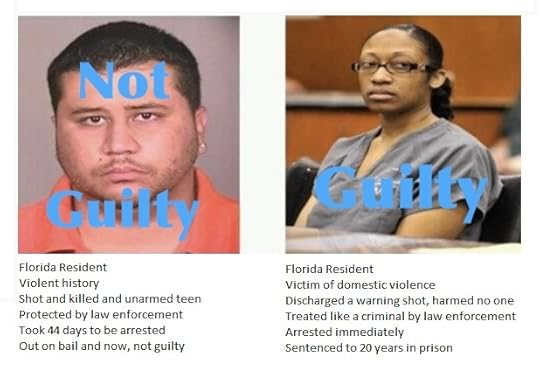 George Zimmerman and Marissa AlexanderAbove all else, we are called to be objective and observe the law. However, in this case, it's Zimmerman's trial that has spawned many conversations of an age-old problem in the United States involving race and the lack of "justice" in the verdict. In another instance involving firearms and Florida residents, we have Marissa Alexander, a survivor of domestic abuse who fired a warning shot to thwart further abuse from her violent partner. She has been sentenced to 20 years in prison while George Zimmerman is a free man. Alexander's case was prosecuted by Angela Corey, the Florida State's Attorney who prosecuted George Zimmerman.
George Zimmerman and Marissa AlexanderAbove all else, we are called to be objective and observe the law. However, in this case, it's Zimmerman's trial that has spawned many conversations of an age-old problem in the United States involving race and the lack of "justice" in the verdict. In another instance involving firearms and Florida residents, we have Marissa Alexander, a survivor of domestic abuse who fired a warning shot to thwart further abuse from her violent partner. She has been sentenced to 20 years in prison while George Zimmerman is a free man. Alexander's case was prosecuted by Angela Corey, the Florida State's Attorney who prosecuted George Zimmerman.
Corey herself stated, in regard to Alexander, "She discharged a gun to kill them, and she has to answer for that."
However, Zimmerman didn't have to answer to anything and he discharged a gun and killed someone unlike Alexander. Marissa didn't harm or kill anyone, but faces 20 years while Zimmerman killed an unarmed teen. Corey, and many in this country on Zimmerman's side and denying that race was a factor, fails to see the irony.
Recently, after discussing the issue of race in the US with someone at a meeting, we came to agreement that discussing trauma is not simply about guilt or pity, it's about acknowledging that there is a problem. In turn, not allowing the problem behavior or for it to be enabled, validating the experience, and ultimately moving on in a positive direction results from discussing even the most uncomfortable topics. But, there are those who want to keep the status quo and perpetuate such actions, and that's part of the problem. These conversations need to keep going. It's when abuse, bigotry, and other forms of hatred are buried and ignored that problems like these persist. There is a nasty racist history that has long been ignored or minimized, but in any case of trauma, whether personal, generational, or historical, it needs to be discussed. If the conversation doesn't continue, no real change can occur. We need to stop burying history and violence in this country and address is openly and honestly.
For George Zimmerman, who basically went out of his way to stir up trouble with an unarmed teen who could have very well stood his own ground in self-defense from an armed stranger following him home, we may never know how viciously he pursued Trayvon Martin's death - or if he really was the curious idiot his defense attorney portrayed him to be. Whether it was really murder or manslaughter, it's discarded now that an aggressor goes completely unpunished. Being a curious coconut is one thing, but needlessly taking someone else's life and then claiming self-defense as an aggressor is another. Zimmerman is now the champion for racists and coconuts everywhere. And worst of all, his verdict sends the message out loud and clear: if you're an unarmed minority walking around and minding your own business, anyone can kill you then claim you to be a pointless thug, a "problem" in the community, and avoid consequences and punishment as a result. Trayvon Martin wasn't a "problem," Zimmerman's lack of identity was, and because of that, a kid armed with Skittles and tea is now dead.
 I remember when I first heard of the term, "coconut." It was a word that was used for people of color who were ashamed of who they were ethnically and made, often embarrassing, moves to hide or deny their ethnicity in order to "assimilate" into a predominantly white society. My family was living in Hawaii at the time, a move that was greatly welcome from a turbulent stint in Alabama where we faced deplorable acts of racism as a multi-racial family. Basically, a coconut is another term for an "Uncle Tom." Someone brown on the outside, but embraced white supremacy on the inside - drunk on the coconut rum on self-hatred.
I remember when I first heard of the term, "coconut." It was a word that was used for people of color who were ashamed of who they were ethnically and made, often embarrassing, moves to hide or deny their ethnicity in order to "assimilate" into a predominantly white society. My family was living in Hawaii at the time, a move that was greatly welcome from a turbulent stint in Alabama where we faced deplorable acts of racism as a multi-racial family. Basically, a coconut is another term for an "Uncle Tom." Someone brown on the outside, but embraced white supremacy on the inside - drunk on the coconut rum on self-hatred.In "Quixote in Ramadi: An Indigenous Account of Imperialism," I've taken what I've personally seen throughout life and painted a picture that serves as a protagonist counter-response to the brand of racism Toni Morrison presents in "The Bluest Eye." Instead of subscribing to destructive self-loathing promoted by relatives and others in the community who shame the protagonist over her ethnic features while championing Anglo-Saxon features (i.e. blonde hair, blue eyes, fair skin), the propaganda is completely discarded. However, an aggressive response takes place, ultimately, to combat the ongoing colonialist views.
George Zimmerman, on the other hand, may have more means to identify with Pecola in "The Bluest Eye." While he is of Peruvian and German descent, it was apparent from the language used and his resulting actions that he is also a product of this brand of racism in the United States that prompts one to either rise above and own one's identity, or to become a coconut. While George Zimmerman is mostly referred to as being white in spite of actually being part Hispanic, and clearly expressed through his 911 call that the unarmed black teen he was stalking was a "problem," he is certainly not unique. I recall meeting a few people just like him, a few from my time in the military that actually sympathize with Zimmerman. One in particular, who was of Mexican/Native American/Caucasian descent used to tell people he wasn't Hispanic, but Spaniard - although he previously admitted his real ethnicity in private and quite shamefully. He also mentioned that in spite of his looks, he would have been better off having blonde hair and blue eyes, then, as he claimed, he'd be even better looking. He shrouded himself in his self-denial and bragged that he only dated blonde white women out of principle while faithfully promoting far-right viewpoints to include profiling Hispanics and other anti-immigrant rants. I always thought those who fell victim to Colonial-speak, or any speech that involved shaming minorities and glorifying Anglo features, were quite pitiful. Yet it doesn't surprise me that this level of self-hatred would prompt someone raised with colonial, patriarchal, self-loathing ideals would put himself in a situation where he is independently attacking other people of color to prove himself worthy in that community.
 George Zimmerman and Marissa AlexanderAbove all else, we are called to be objective and observe the law. However, in this case, it's Zimmerman's trial that has spawned many conversations of an age-old problem in the United States involving race and the lack of "justice" in the verdict. In another instance involving firearms and Florida residents, we have Marissa Alexander, a survivor of domestic abuse who fired a warning shot to thwart further abuse from her violent partner. She has been sentenced to 20 years in prison while George Zimmerman is a free man. Alexander's case was prosecuted by Angela Corey, the Florida State's Attorney who prosecuted George Zimmerman.
George Zimmerman and Marissa AlexanderAbove all else, we are called to be objective and observe the law. However, in this case, it's Zimmerman's trial that has spawned many conversations of an age-old problem in the United States involving race and the lack of "justice" in the verdict. In another instance involving firearms and Florida residents, we have Marissa Alexander, a survivor of domestic abuse who fired a warning shot to thwart further abuse from her violent partner. She has been sentenced to 20 years in prison while George Zimmerman is a free man. Alexander's case was prosecuted by Angela Corey, the Florida State's Attorney who prosecuted George Zimmerman. Corey herself stated, in regard to Alexander, "She discharged a gun to kill them, and she has to answer for that."
However, Zimmerman didn't have to answer to anything and he discharged a gun and killed someone unlike Alexander. Marissa didn't harm or kill anyone, but faces 20 years while Zimmerman killed an unarmed teen. Corey, and many in this country on Zimmerman's side and denying that race was a factor, fails to see the irony.
Recently, after discussing the issue of race in the US with someone at a meeting, we came to agreement that discussing trauma is not simply about guilt or pity, it's about acknowledging that there is a problem. In turn, not allowing the problem behavior or for it to be enabled, validating the experience, and ultimately moving on in a positive direction results from discussing even the most uncomfortable topics. But, there are those who want to keep the status quo and perpetuate such actions, and that's part of the problem. These conversations need to keep going. It's when abuse, bigotry, and other forms of hatred are buried and ignored that problems like these persist. There is a nasty racist history that has long been ignored or minimized, but in any case of trauma, whether personal, generational, or historical, it needs to be discussed. If the conversation doesn't continue, no real change can occur. We need to stop burying history and violence in this country and address is openly and honestly.
For George Zimmerman, who basically went out of his way to stir up trouble with an unarmed teen who could have very well stood his own ground in self-defense from an armed stranger following him home, we may never know how viciously he pursued Trayvon Martin's death - or if he really was the curious idiot his defense attorney portrayed him to be. Whether it was really murder or manslaughter, it's discarded now that an aggressor goes completely unpunished. Being a curious coconut is one thing, but needlessly taking someone else's life and then claiming self-defense as an aggressor is another. Zimmerman is now the champion for racists and coconuts everywhere. And worst of all, his verdict sends the message out loud and clear: if you're an unarmed minority walking around and minding your own business, anyone can kill you then claim you to be a pointless thug, a "problem" in the community, and avoid consequences and punishment as a result. Trayvon Martin wasn't a "problem," Zimmerman's lack of identity was, and because of that, a kid armed with Skittles and tea is now dead.
Published on July 21, 2013 13:33
July 11, 2013
Hearts Buried at Wounded Knee
 One of the country’s poorest Native American tribes wants to buy a historically significant piece of land where 300 of their ancestors were killed, but tribal leaders say the nearly $4 million price tag for a property appraised at less than $7,000 is just too much.
One of the country’s poorest Native American tribes wants to buy a historically significant piece of land where 300 of their ancestors were killed, but tribal leaders say the nearly $4 million price tag for a property appraised at less than $7,000 is just too much.James Czywczynski is trying to sell a 40-acre fraction of the Wounded Knee National Historic Landmark on the Pine Ridge Indian Reservation to the Oglala Sioux Tribe. The land sits adjacent to a grave site where about 150 of the 300 Lakota men, women and children killed by the 7th Cavalry in 1890 are buried. Czywczynski, whose family has owned the property since 1968, recently gave the tribe an ultimatum: purchase the land for $3.9 million or he will open up bidding to non-Native Americans. He said he has been trying to sell the land to the tribe for years. The ultimatum comes right before the tribe is poised to receive about $20 million from the Cobell lawsuit— a $3.4 billion settlement stemming from a class-action lawsuit filed over American Indian land royalties mismanaged by the government for more than a century. (Change.org)
Tell James Czywczynski to sell Wounded Knee site back to Oglala Sioux Tribe for fair market value by signing the online petition: click here
If you haven't had that much education in indigenous massacres such as Wounded Knee, I would highly recommend reading Dee Brown's " Bury My Heart at Wounded Knee " as a primer. There is also an HBO special available, but as with most adaptations, it got a bit creative on factual information.
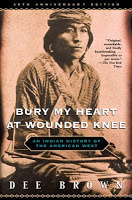 Buy on Amazon
If you haven't already noticed how limited availability of books on Native American history, visit your local bookseller and take a look for yourself. You will find "American history" - or a highly European-biased edition of such history - as well as European, Asian, African, Latino, and more regional history. However, more often than not, the Native American section will be close to nonexistent. A few shelves perhaps - if you're lucky and perhaps in Arizona or New Mexico - and that's it. This is their land and such history needs to be known. Even in Tucson, politicians are fighting to remove books about Native and Latino history from classrooms (HB 2281). The under-representation of indigenous peoples and how the open discrimination persists is appalling. Forcing someone to pay nearly $4 million to buy their own land back after it was stolen is like having someone break into your house, murder your family, kick you out onto the street, and try to sell your own house back to you for 571 times the value. Support this cause and, at the very least,
sign the petition
.
Buy on Amazon
If you haven't already noticed how limited availability of books on Native American history, visit your local bookseller and take a look for yourself. You will find "American history" - or a highly European-biased edition of such history - as well as European, Asian, African, Latino, and more regional history. However, more often than not, the Native American section will be close to nonexistent. A few shelves perhaps - if you're lucky and perhaps in Arizona or New Mexico - and that's it. This is their land and such history needs to be known. Even in Tucson, politicians are fighting to remove books about Native and Latino history from classrooms (HB 2281). The under-representation of indigenous peoples and how the open discrimination persists is appalling. Forcing someone to pay nearly $4 million to buy their own land back after it was stolen is like having someone break into your house, murder your family, kick you out onto the street, and try to sell your own house back to you for 571 times the value. Support this cause and, at the very least,
sign the petition
.
Published on July 11, 2013 09:50
June 30, 2013
Elements of Abuse
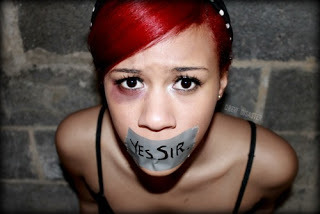 Since writing "Quixote in Ramadi," there has been an outcry from perpetrators whom are depicted in the novel. Such individuals have resorted to telling me that speaking about abuse in a book is "wrong" and that I should be "respectful" and maintain my silence, so as not to offend the people I'm portraying. This demonstration in a lack of self-awareness is part of what contributes to abusive behavior. Abusers who cry foul when confronted while continually victimizing others is not something in which I can call respectful and remain silent. There comes a point where one can either choose to succumb to the abuse or draw the line by addressing the root causes. I choose the latter.
Since writing "Quixote in Ramadi," there has been an outcry from perpetrators whom are depicted in the novel. Such individuals have resorted to telling me that speaking about abuse in a book is "wrong" and that I should be "respectful" and maintain my silence, so as not to offend the people I'm portraying. This demonstration in a lack of self-awareness is part of what contributes to abusive behavior. Abusers who cry foul when confronted while continually victimizing others is not something in which I can call respectful and remain silent. There comes a point where one can either choose to succumb to the abuse or draw the line by addressing the root causes. I choose the latter.Whether one is enduring or has experienced physical, psychological, or sexual abuse, here are some factors that abusers often resort to in order to keep someone in a victim mindset:
1. Disempowerment - The goal of the abuser to to take away any power base from the victim, leaving the individual to question their self-worth and disabling any thoughts on self-defense. This is done in anticipation that the victim will either become dependent on the abuser or will have little to no resources to turn to in the event of any rejection of the abuse. Sources of support to include friends, family, colleagues, and other avenues of assistance to remove the abuse are, in turn, attacked by the abuser to further disempower the victim. The goal is for the victim to acknowledge the abuser as an unquestionable authority figure regardless of legal or ethical conflicts.
2. Exhaustion - An abuser intends to not only take away one's ability to thrive, but also resorts to tactics which are intended to exhaust the victim on a physiological and/or psychological level. The intent is to overwhelm the victim, cause confusion, and ultimately halt any rebuttal or conscious efforts to maintain personal security. When one is confused, one loses their situational awareness and any efforts in effective decision making and communication become impaired. The goal is to diminish motivation and ability in the victim to fight back.
3. Humiliation - Efforts to exhaust and degrade the victim are often accompanied by behaviors and speech involving humiliation. From hate speech based on gender, ethnicity, background, beliefs, or anything belonging to the victim's identity to physically embarrassing the victim, humiliation takes on various forms. Humiliation involves violence on some level and most of such violence involves some knowledge, familiarity or intimacy between victim and the abuser. Institutional violence (discrimination, racial persecution, etc) or direct violence (hate crimes, sexual assault, etc) are forms of humiliation. Victim-shaming after a traumatic event also falls into this category. The goal is to cause intense anguish and pain in order to prevent the victim from believing that there is any hope and for the victim to perceive that they are "beneath" the abuser.
4. Manipulation - An abuser, in effort to maintain power, may resort to manipulating previous positive memories or prior intimacy to convince the victim that they are cared for in spite of abuse. When one is busy questioning the presence of love in the realm of abuse, one is also too busy to confront the abuser effectively. Efforts to make the victim feel isolated, invisible, or insignificant can be committed through manipulation involving indifference, apathy, or denying the victim's experience. The goal is to confuse the victim and convince them that the abusive behavior is acceptable instead of addressing it.
5. Distortion - In effort of self-preservation, an abuser will often turn to distorting events to refrain from any accountability or responsibility toward the victim. Distortion is an egregious effort to silence the victim through insidious speech or behavior that involves a gross lack of integrity, accountability, and respect. The goal is to convince the victim that the abuse simply "didn't happen" or to forget about pursuing justice related to the trauma all together.
While these are only a few aspects of abusive behavior, these manifestations of abuse can exist in families, relationships, workplaces, and everywhere else involving human interaction. Abuse can only be stopped through confronting and halting the behavior, in addition to acknowledging any enabling factors or parties and addressing them accordingly. In the end, if we are victimized, we can choose to survive, to end abuse and, ultimately, lead the way into a healthier future.
To read more about what's getting abusers riled up, check out "Quixote in Ramadi" on Amazon: click here.
Published on June 30, 2013 13:39
June 20, 2013
Quixote in the Las Vegas Review-Journal
By SONYA PADGETT LAS VEGAS REVIEW-JOURNAL
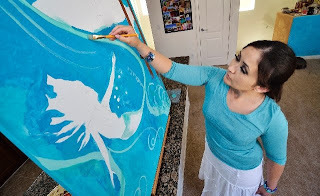 When Michelle Wilmot first returned from Iraq, she numbed herself with a steady diet of Cap’n Crunch cereal and Arby’s. It wasn’t the healthy outlet that art now provides for the Army veteran. The 31-year-old has amassed a portfolio of dozens of paintings, drawings and mixed-media pieces since she turned to art to deal with the feelings and frustrations left over from her military career. But for a few weeks, before art became her salvation, the self-medication worked. The constant supply of fat and sugar kept her true feelings stuffed deep inside where she didn’t have to face the truth: that she had been forever altered by the things she did and saw during the war. And she had yet to be presented with the reality that her role as a female combat veteran would be challenged again and again by a society that is still not comfortable with the idea of women fighting its wars. Read More
When Michelle Wilmot first returned from Iraq, she numbed herself with a steady diet of Cap’n Crunch cereal and Arby’s. It wasn’t the healthy outlet that art now provides for the Army veteran. The 31-year-old has amassed a portfolio of dozens of paintings, drawings and mixed-media pieces since she turned to art to deal with the feelings and frustrations left over from her military career. But for a few weeks, before art became her salvation, the self-medication worked. The constant supply of fat and sugar kept her true feelings stuffed deep inside where she didn’t have to face the truth: that she had been forever altered by the things she did and saw during the war. And she had yet to be presented with the reality that her role as a female combat veteran would be challenged again and again by a society that is still not comfortable with the idea of women fighting its wars. Read More
 When Michelle Wilmot first returned from Iraq, she numbed herself with a steady diet of Cap’n Crunch cereal and Arby’s. It wasn’t the healthy outlet that art now provides for the Army veteran. The 31-year-old has amassed a portfolio of dozens of paintings, drawings and mixed-media pieces since she turned to art to deal with the feelings and frustrations left over from her military career. But for a few weeks, before art became her salvation, the self-medication worked. The constant supply of fat and sugar kept her true feelings stuffed deep inside where she didn’t have to face the truth: that she had been forever altered by the things she did and saw during the war. And she had yet to be presented with the reality that her role as a female combat veteran would be challenged again and again by a society that is still not comfortable with the idea of women fighting its wars. Read More
When Michelle Wilmot first returned from Iraq, she numbed herself with a steady diet of Cap’n Crunch cereal and Arby’s. It wasn’t the healthy outlet that art now provides for the Army veteran. The 31-year-old has amassed a portfolio of dozens of paintings, drawings and mixed-media pieces since she turned to art to deal with the feelings and frustrations left over from her military career. But for a few weeks, before art became her salvation, the self-medication worked. The constant supply of fat and sugar kept her true feelings stuffed deep inside where she didn’t have to face the truth: that she had been forever altered by the things she did and saw during the war. And she had yet to be presented with the reality that her role as a female combat veteran would be challenged again and again by a society that is still not comfortable with the idea of women fighting its wars. Read More
Published on June 20, 2013 09:34
June 17, 2013
Memories From Jack London Square
 It's a surreal and overwhelming feeling. I recall when I moved to the Bay Area in 1997 and took my first visit to Jack London Square's Barnes & Noble in Oakland, CA. It was magical for me then. Having lived in Guam for a few years and Hawaii before that, the idea of warehouse-sized bookstores hadn't exactly crossed my mind.
It's a surreal and overwhelming feeling. I recall when I moved to the Bay Area in 1997 and took my first visit to Jack London Square's Barnes & Noble in Oakland, CA. It was magical for me then. Having lived in Guam for a few years and Hawaii before that, the idea of warehouse-sized bookstores hadn't exactly crossed my mind. The first time I set foot inside the colossal bookstore - which is now closed at Jack London Square - I was speechless, but ready to read. I walked around in circles, perhaps for the entire first hour, trying to wrap my head around the possibilities, the variety in front of me. In my teens, I was big into books on foreign languages, psychology, mysticism, and history. I dreamed that one day I'd write a book that Barnes & Noble would sell. As I sat on the floor in the aisle, devouring another book on Jung or rifling through Greek tragedies, I'd sometimes close my eyes for a second and imagine one of my works appearing on a shelf before me. I had no idea how I would get there, but I held onto that vision for years to today.
Happily, I can tell you today that this vision I had while reading on the floor in Barnes & Noble is now a reality. Not only have I been mentioned in a few books that currently take up real estate in the military history section, as well as having published a chapter on women veterans in "War Trauma and Its Wake," I currently have a title available through Amazon and Barnes & Noble entitled, "Quixote in Ramadi: An Indigenous Account of Imperialism."
You can purchase this new novel today through the links below and, just remember, maintain your vision and go for your dreams - no matter how distant they may appear. As Jack London once said: "You can't wait for inspiration. You have to go after it with a club."
Amazon
Barnes & Noble
Published on June 17, 2013 17:18
Quixote in Ramadi - Now in Paperback!
 Click here to buyNow available! Purchase a copy of "Quixote in Ramadi: An Indigenous Account of Imperialism"
here
.
Click here to buyNow available! Purchase a copy of "Quixote in Ramadi: An Indigenous Account of Imperialism"
here
.“Quixote in Ramadi: An Indigenous Account of Imperialism” is a dark humor novel that is introspective and capricious, despite dealing with the serious issues of childhood abuse, neo-colonialism, homicide, genocide, and ethnic persecution. It tells the story of an indigenous female soldier in the US Army who deploys to Iraq at the height of the tension of the Fallujah massacre and the Abu Ghraib scandal, and faces unexpected catastrophes and corruption. While her command leadership frivolously spends defense funds in Baghdad's Green Zone and turns local Iraqis into personal servants, she is sent along with three other soldiers to one of the most dangerous cities in Iraq, Ar Ramadi. In Ar Ramadi, she faces direct combat while performing checkpoint operations, personnel searches and house raids with Marine infantry units in addition to losing friends, earning the trust of locals, and responding to military suicides and homicides in the region. This takes place all while her command severs their supplies, escalates persecution of minorities in the company, and launders thousands of dollars in defense funds intended for equipment and radios for those in austere regions like Ar Ramadi. This unit, ironically, is an Army mental health company. A Jewish officer and the indigenous soldier fight the command and are threatened with imprisonment. Although they faced brazen retaliation, they refused to be terrorized into submission. The soldier confides in her predominantly male Marine counterparts of the abuse taking place, who then encourage her to take matters into her own hands. The soldier is forced to confront the powers that be and finds herself facing the same trials as her ancestors. She fights to prevent the same history from repeating itself in Iraq. Throughout “Quixote in Ramadi,” flashbacks to child abuse, racial inequality, and family history are tied in to reveal myriad social and racial injustices that still exist in the United States.
Published on June 17, 2013 09:33



